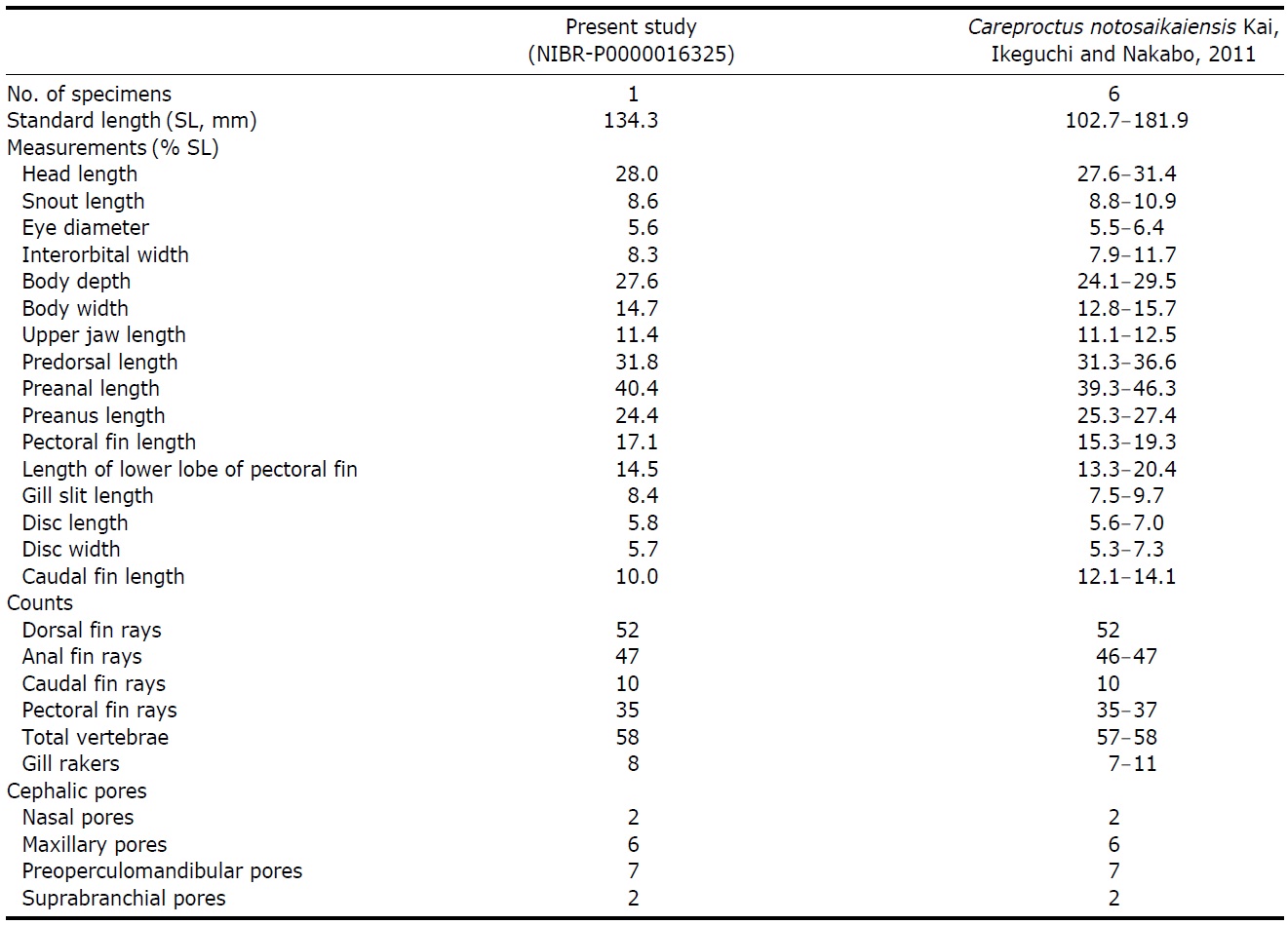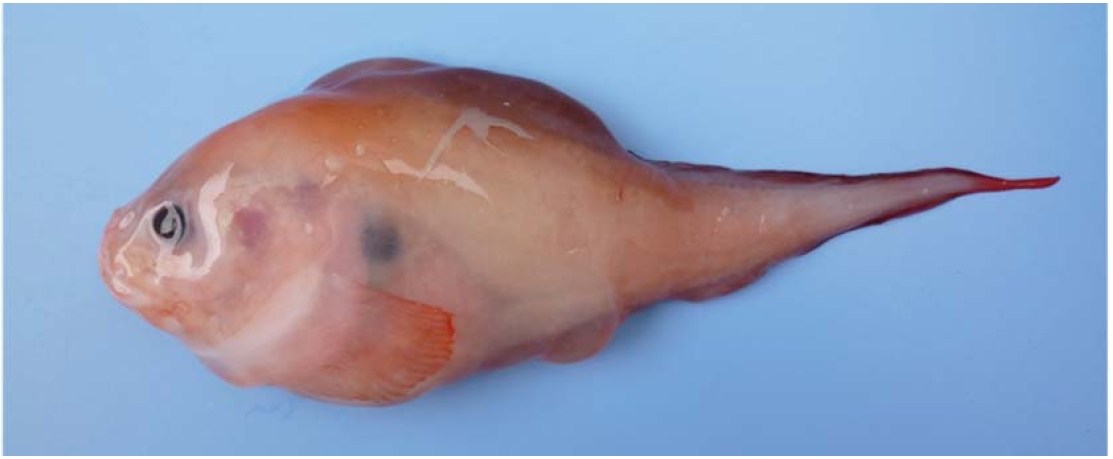The genus Careproctus Krøyer , 1862 belongs to the family Liparidae in the order Scorpaeniformes are distributed in Atlantic, Pacific, Antarctic, and Arctic waters, and are known mainly from the deeper waters of the continental slope (Chernova et al., 2004; Orr and Maslenikov, 2007). The genus comprises 112 species (Chernova et al., 2004; Orr and Maslenikov, 2007; Eschmyer and Fricke, 2011; Kai et al., 2011), of which 50 species are known from the North Pacific (Chernova et al., 2004), 22 from Japan (Nakabo, 2002; Sakurai and Shinohara, 2008; Kai et al., 2011), and a only single species, Careproctus rastrinus, from Korea (Kim et al., 2001, 2005).
In Korea, firstly C. rastrinus was reported by Kim et al. (1988) in the Fishes of the North Pacific Ocean; later, two species (Careproctus furcellus, Careproctus sp.) were described by Lee et al. (1999), also in the Fishes of the Pacific Ocean. The first description of C. rastrinus collected from Korea was made by Kim et al. (2001); later, Kim et al. (2005) reported the occurrence of C. rastrinus in Goseong and Sokcho, Gangwon-do, Korea.
Careproctus species are defined by the following combination of morphological characters: single pair of nostrils; presence of a pelvic disk; fewer pectoral fin rays than anal fin rays; absence of pseudobranchia; and non-variegated body color, except for the fins (Kido, 1988; Stein et al., 2001). Recently, several taxonomic studies of Careproctus species have been conducted. Kido (1988) reported on the morphological characteristics of 18 Careproctus species; subsequently, some new species have been reported (Orr and Maslenikov, 2007; Sakurai and Shinohara, 2008; Kai et al., 2011).
A single specimen of the species Careproctus notosaikaiensis was collected from a fish trap in Goseong, Gangwondo, East Sea, Korea. We here describe this first recorded instance of C. notosaikaiensis in Korea on the basis of this specimen. Counts and measurements followed those of Andriashev and Stein (1998). Cephalic pore terminology and the counts of pectoral fin rays followed those of Orr and Busby (2006). Each body part was measured to the nearest 0.1 mm using digital Vernier calipers. The numbers of vertebrae and fin rays were counted from radiographs (Hitex HA- 100; Hitex Co., Tokyo, Japan). The present specimen of C. notosaikaiensis is deposited in the National Institute of Biological Resources (NIBR), Korea.
Order Scorpaeniformes
Family Liparidae Scopoli, 1777
Genus Careproctus Krøyer, 1862
1*Careproctus notosaikaiensis Kai, Ikeguchi, and Nakabo, 2011 (Table 1, Fig. 1)
Careproctus notosaikaiensis Kai, Ikeguchi, and Nakabo, 2011 (type locality: off Saikai, Japan).
Material examined. 1 specimen, 134.3 mm standard length (SL), Gangwon-do, Goseong-gun, 23 Aug 2011, Park JH, NIBR-P0000016325, from a fish trap at 200 m water depth.
Description. Dorsal fin rays 52; Anal fin rays 47; Pectoral fin rays 35; caudal fin rays 10; vertebrae 11+47=58; ribs, 2; gill rakers, 8; cephalic pores, 2-6-7-2.
Counts and proportional measurements are shown in Table 1. Body somewhat high, compressed, and tapering to tail. Head moderately large and slightly compressed; dorsal profile of head concave. Eye relatively large; pupil round. Single pair of tubular nostrils, located in front of eye. Snout rounded. Mouth subterminal; upper and lower jaw lengths equal; posterior tip of upper jaw reaching to middle part of eye. Teeth small, well-developed, and trilobed; arranged in 7-11 oblique rows clustered in wide bands on both jaws. Inner teeth strongly trilobed and larger than outer teeth. Cephalic pores well developed: nasal pores, 2; maxillary pores, 6; preoperculomandibular pores, 7; suprabranchial pores, 2. Chin pores paired and equal in size; present on ventral side of lower jaw. Upper margin of gill slit at level of dorsal margin of eye, extending to the 5th pectoral fin ray. Opercular flap angular and pointed slightly dorsally. Gill rakers short. Pectoral fin distinctly notched; upper lobe with 26 rays, not reaching origin of anal fin; lower lobe somewhat short, with 9 rays, extending beyond anus. Dorsal fin origin above middle of pectoral fin. Caudal fin narrow and truncate. Ventral disk small and rounded; anus close to disk.
Color. When fresh: body and head generally pinkish; abdominal cavity somewhat black; cephalic pores and tubular nostrils white; dorsal, anal, and caudal fins with distinct reddish margins; pectoral fin pale reddish; eye generally black without sclera. In ethanol: body and head pale white; abdominal cavity somewhat black; dorsal, anal, and caudal fins with black margins; pectoral and caudal fins pale white.
Distribution. Goseong, Gangwon-do, East Sea, Korea, at 200 m water depth (present study). Off Saikai, west coast of the Noto Peninsula, Japan (Kai et al., 2011).
Remarks. This specimen is identified as belonging to the genus Careproctus, based on the following characters: body generally pinkish; fewer pectoral fin rays than anal fin rays; absence of pseudobranchia; non-variegated body color, except for the fins (Kido, 1988; Stein et al., 2001). Based on comparisons with Careproctus species from the North Pacific, the specimen was identified as C. notosaikaiensis by numbers of dorsal, anal, pectoral, and caudal fin rays, and numbers of vertebrae, gill rakers, and ribs (Table 1). In particular, the specimen shows a strong correspondence with C. notosaikaiensis, in having: strongly trilobed teeth; paired, equal-sized chin pores; gill slits extending to the 5th pectoral fin ray; 2 pairs of ribs; distinctly reddish margins of the dorsal and anal fins (Kai et al., 2011). The specimen differs slightly from C. notosaikaiensis in the lengths of the caudal fins and preanal fins (Table 1); these differences are thought to represent regional variations, although genetic analyses are required for clarification. Careproctus notosaikaiensis is most similar to C. rastrinus in terms of meristic characters; however, they are easily distinguished by the shape of their teeth (trilobed in C. notosaikaiensis vs. conical in C. rastrinus) and the numbers of caudal fin rays (10 in C. notosaikai-
ensis vs. 9 in C. rastrinus) (Nakabo, 2002; Kim et al., 2005). Careproctus notosaikaiensis is also similar to Careproctus bowersianus in terms of meristic characters, but they are distinguished by the numbers of ribs (2 in C. notosaikaiensis vs. 3 in C. bowersianus) and the colors of the dorsal and anal fins (distinctly reddish in C. notosaikaiensis vs. uniformly pinkish in C. bowersianus) (Gilbert and Burke, 1912; Burke, 1930). Careproctus notosaikaiensis is also similar to Careproctus simus in having strongly trilobed teeth, dark margined dorsal and anal fins and gill slits extending to pectoral fin ray; however, they are distinguished by the size of chin pores (equal size in C. notosaikaiensis vs. different size in C. simus) and the number of dorsal fin rays (52 in C. notosaikaiensis vs. 54-60 in C. simus) (Nakabo, 2002; Chernova et al., 2004). We here propose a new Korean name “Dong-hae-bun-hongggom- chi” for C. notosaikaiensis.
Korean name: 1*동해분홍꼼치






